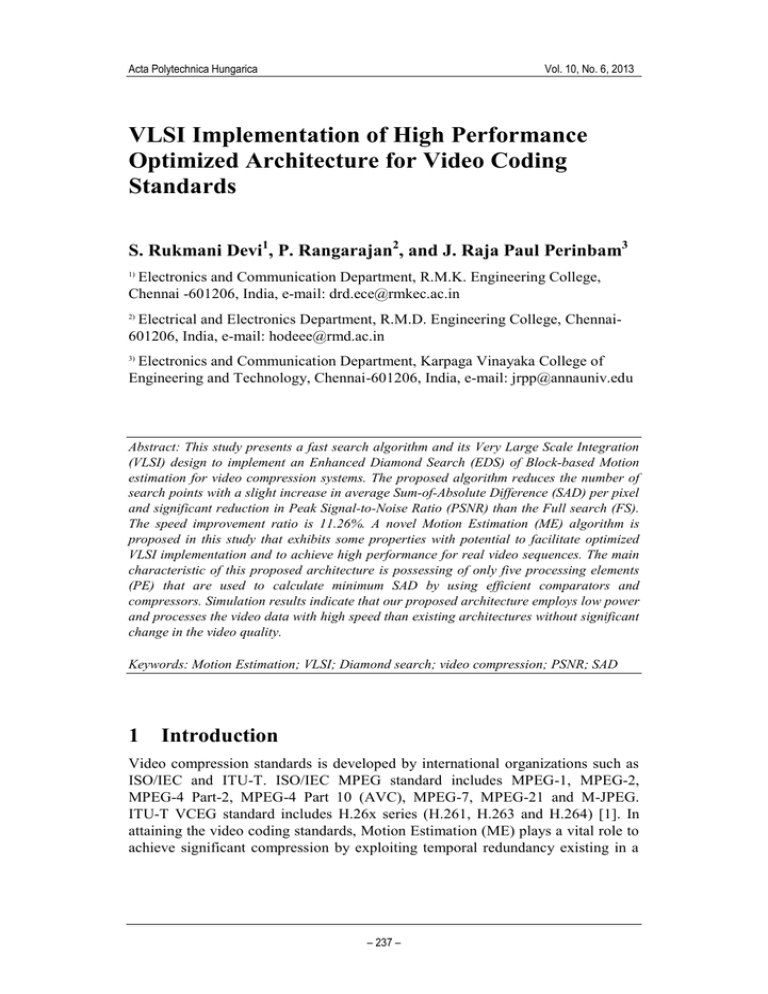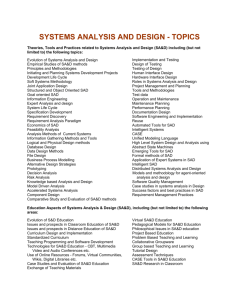VLSI Implementation of High Performance Optimized Architecture for Video Coding Standards
advertisement

Acta Polytechnica Hungarica
Vol. 10, No. 6, 2013
VLSI Implementation of High Performance
Optimized Architecture for Video Coding
Standards
S. Rukmani Devi1, P. Rangarajan2, and J. Raja Paul Perinbam3
1)
Electronics and Communication Department, R.M.K. Engineering College,
Chennai -601206, India, e-mail: drd.ece@rmkec.ac.in
2)
Electrical and Electronics Department, R.M.D. Engineering College, Chennai601206, India, e-mail: hodeee@rmd.ac.in
3)
Electronics and Communication Department, Karpaga Vinayaka College of
Engineering and Technology, Chennai-601206, India, e-mail: jrpp@annauniv.edu
Abstract: This study presents a fast search algorithm and its Very Large Scale Integration
(VLSI) design to implement an Enhanced Diamond Search (EDS) of Block-based Motion
estimation for video compression systems. The proposed algorithm reduces the number of
search points with a slight increase in average Sum-of-Absolute Difference (SAD) per pixel
and significant reduction in Peak Signal-to-Noise Ratio (PSNR) than the Full search (FS).
The speed improvement ratio is 11.26%. A novel Motion Estimation (ME) algorithm is
proposed in this study that exhibits some properties with potential to facilitate optimized
VLSI implementation and to achieve high performance for real video sequences. The main
characteristic of this proposed architecture is possessing of only five processing elements
(PE) that are used to calculate minimum SAD by using efficient comparators and
compressors. Simulation results indicate that our proposed architecture employs low power
and processes the video data with high speed than existing architectures without significant
change in the video quality.
Keywords: Motion Estimation; VLSI; Diamond search; video compression; PSNR; SAD
1
Introduction
Video compression standards is developed by international organizations such as
ISO/IEC and ITU-T. ISO/IEC MPEG standard includes MPEG-1, MPEG-2,
MPEG-4 Part-2, MPEG-4 Part 10 (AVC), MPEG-7, MPEG-21 and M-JPEG.
ITU-T VCEG standard includes H.26x series (H.261, H.263 and H.264) [1]. In
attaining the video coding standards, Motion Estimation (ME) plays a vital role to
achieve significant compression by exploiting temporal redundancy existing in a
– 237 –
D. R. Devi et al.
VLSI Implementation of High Performance Optimized Architecture for Video Coding Standards
video sequence. ME is the most computationally intensive functions of the entire
video coding process. Of several algorithms available for block matching motion
estimation, full search algorithm identifies the best match in the entire search
window by computation of SAD at each location. For a search window of size +/W pixels, the number of search locations is (2W+1)2[2]. For a search window of
31 x 31 and a block size of 16 x 16, a total of 961 locations will be searched to
obtain a best match with a minimum SAD value. This results in significant
computational complexity and consumes up to 80% of the computing power of the
encoder. To reduce the computational complexity, numerous optimized search
algorithm are available as follows: Three Step Search (TSS), New Three Step
Search (NTSS), Four Step Search (FSS), Block Based Gradient Descent Search
(BBGDS), Diamond Search (DS), Hexagon–Based Search (HEXBS), Adaptive
Rood Pattern Search (ARPS), Cross Diamond Search (CDS) [3-12]. The TSS
reduces the number of computations by using a coarse-to-fine search strategy. The
other algorithms mentioned above reduces the number of computations in relation
to TSS by using a center-biased motion vector distribution characteristics. In real
world video sequences, the motion of blocks are as stationary or quasi-stationary.
If blocks are stationary (about 40%-60%), the corresponding Motion Vectors
(MVs) are located at the search center and if the blocks are quasi-stationary (30%
-40%), the corresponding MVs are enclosed in a window of size ±2 pixel distance
around the center [13-14].
In this paper, we propose an Enhanced Diamond Search (EDS) algorithm for fast
block motion estimation algorithm. After analyzing, the characteristics of the
MVs, the search pattern of Large Cross Diamond Pattern (LCDP) consists of five
search points with pixel distances of ±2 and Small Cross Diamond Pattern (SCDP)
consists of four search points with pixel distance of ±1 based on the origin. This
proposed algorithm achieves fewer search points and better Peak Signal-to-Noise
Ratio (PSNR) than DS, CDS and other fast search algorithms.
The real time processing of video signals requires tremendous computational
capabilities that can only be achieved cost effectively by using VLSI. The
usefulness of motion estimation algorithms strongly depends on the feasibility and
effectiveness of its VLSI implementation. We propose low cost optimized high
performance architecture for EDS algorithm used for low bit rate applications.
This paper is organized as follows: Section 2 discusses about proposed algorithm,
Section 3 deals with proposed hardware architecture Section 4 describes about
synthesis results and conclusion given in the Section 5.
– 238 –
Acta Polytechnica Hungarica
2
Vol. 10, No. 6, 2013
Enhanced Diamond Search Algorithm
The EDS algorithm has two cross diamond patterns such as a large cross diamond
pattern (LCDP) and small cross diamond pattern (SCDP) as shown in Figure 1(a)
and Figure 1(b). It consists of five candidate search points suitable for exploiting
the center biased characteristic of motion vector distribution. Figure 2 shows the
position of the diamond, with respect to the previous position, for the next search.
At subsequent steps, three or two new candidate search points to be evaluated with
the maximum overlapping region are required to minimize the number of search
points. To obtain the minimum SAD, the final search step with four new candidate
search points is evaluated.
Figure 1 (a)
Large Cross Diamond Pattern (LCDP)
Figure 1(b)
Small Cross Diamond Pattern (SCDP)
Figure 1
The EDS patterns
In order to describe the EDS algorithm, a sum of absolute difference (SAD)
obtained by employing the following formula[8]
(1)
Where N is the block size & CB and RB are the pixel values in the current
block and the reference block respectively. PSNR characterizes t h e motion
compensated i m a g e created b y predicting motion vectors and blocks from
the reference frame using the following formula [3]
PSNR = 10 log 10 {(2b -1)2/MSE}
(2)
– 239 –
D. R. Devi et al.
VLSI Implementation of High Performance Optimized Architecture for Video Coding Standards
Where b is the number of bits per pixel and MSE is Mean Square Error.
Figure 2
Search path example
The EDS algorithm is summarized as follows:
Step 1. The LCDP is placed at (0, 0) the center of the search window. The SAD is
calculated for each of the 5 candidate search points .If the minimum SAD is found
to be at the center (a, a) of the LCDP, jump to step 4.
Step 2. If the minimum SAD in the previous search step is located at any one of
the vertices i.e. (a±2, a) and (a, a±2), then proceed with step 3.
Step 3. Obtain minimum SAD by repositioning the LCDP considering three and
two new candidate search points with a pixel distance of ±2. If the new minimum
SAD is still at the center of the newly formed LCDP, proceed to step 4, otherwise
continue with step 3. A candidate search point that extends beyond the search
window is ignored.
Step 4. A new SCDP is formed, if the minimum SAD is in the center of LCDP.
Add four new search points with a pixel distance of ±1 to identify the new
minimum SAD. If the minimum SAD is at the center of SCDP, the algorithm
stops and corresponding SAD value is considered as the final value of MV. The
flowchart of this algorithm is shown in Figure 3.
– 240 –
Acta Polytechnica Hungarica
Vol. 10, No. 6, 2013
Figure 3
Flowchart of the EDS algorithm
2.1
Software Analysis
A software analysis was performed to evaluate the average number of search
points per block, average SAD per pixel and PSNR using MATLAB and results
are compared for two different video sequences as given in the Table 1. The
search area employed was 32 x 32 pixels with block size of 16 x 16 pixels. The
algorithm was applied to the first 30 frames of CIF video sequences with a
resolution of 352 x 288 pixels.
Table 1
Comparison of DS and proposed algorithm for two video sequences
DS
Sequences
Foreman
Mobile
Average
No. of
search
points /
Block
13.99
17.51
Proposed
5.920
Peak
Signal-toNoise
Ratio
(PSNR)
33.591
Average
No. of
search
points /
Block
10.30
11.734
32.582
11.62
Average
SAD /
Pixel
– 241 –
5.996
Peak
Signalto-Noise
Ratio
(PSNR)
33.615
11.957
32.699
Average
SAD /
Pixel
D. R. Devi et al.
3
VLSI Implementation of High Performance Optimized Architecture for Video Coding Standards
Proposed Hardware Architecture
The proposed architecture consists of current block memory, reference block
memory, data-fetch unit, data-fetch initializer, Processing Element (PE) array,
comparator, PE array Enabler and Timing and control unit as shown in Figure 4.
To start Motion Estimation (ME) process, it is necessary to fill the reference block
memory and the current memory block. The reference block memory is 32 x 32
bytes memory, which can store all data to perform SAD operations and the final
refinement. The current block memory is 16 x 16 bytes and it contains the block
being processed. The data-fetch initializer initializes the data-fetch unit to fetch
reference pixels and current pixels from the memory, row and column address of
the block at the center of the reference frame and type of fetching i.e. pixels of
horizontal or vertical direction .It also calculates starting address of the values to
be fetched, number of search points to be fetched at a time and number of cycles
needed to fetch data input. After initializing, the data-fetch unit obtains the pixel
values from the current and reference block. The pixel values are applied to the PE
array. A PE array with 5 processing elements is used to calculate SAD between
the current block and reference block. Totally five SAD values are generated by
the PE array and these are compared by the comparator to evaluate minimum SAD
or best motion vector and position of the motion vector. The process is repeated
until the comparator finds the lowest SAD in the center of the EDS. Low power
can be achieved by using the PE array enabler. This block is used to enable
appropriate processing element based on the search path. The timing and control
unit is a finite state machine, which is used to control all the blocks presented in
the proposed architecture.
Figure 4
Proposed Optimized Architecture of the EDS algorithm
– 242 –
Acta Polytechnica Hungarica
3.1
Vol. 10, No. 6, 2013
Processing Element
The PE array was designed with five processing elements and four stage pipeline
for better performance. It consists of an absolute difference unit, adder array and
accumulator as shown in Figure 5. The internal structure of the PE is composed of
a large number of addition operations to calculate the SAD. These operations can
be performed effectively by using 5-2 and 3-2 adder compressors [15-19] as
shown Figure 8(a).
Figure 5
Processing Element
The absolute difference unit is used to evaluate the absolute differences between
two pixels. It consists of eight 1-bit comparators (1-bit CMP), seven 2-bit
comparators (2-bit CMP) and two XOR arrays [15-19] as shown in Figure 6. The
1-bit CMP is formed by a XOR gate and two AND gates. It produces three output
signals: they are less than (LE), Equal to (NE) and greater than (LG), as shown in
Figure 7 (a). The 2-bit comparator is formed by using two 1-bit CMP as shown in
Figure 7 (b).
– 243 –
D. R. Devi et al.
VLSI Implementation of High Performance Optimized Architecture for Video Coding Standards
Figure 6
Absolute Difference Unit (Proposed by LiYufei et.al)
Figure 7 (a)
1-bit Comparator
Figure 7 (b)
2-bit Comparator
Processing element (PE) performs a large number of additions that can be
optimized by using 5-2 and 3-2 compressor for an 8-bit number as shown in
Figure 8. The internal structure of 5-2 and 3-2 compressors are shown in Figure
9(a) and Figure 9(b).
– 244 –
Acta Polytechnica Hungarica
Vol. 10, No. 6, 2013
Figure 8
5-2 Compressor and 3-2 Compressor
Figure 9 (a)
Internal structure of 5-2 compressor
Figure 9 (b)
Internal structure of 3-2 compressor
Depending on the search path, the PE generates SAD values. These values are
compared by using comparator (as shown in figure 4) and minimum SAD is
obtained. For optimization purposes, the comparator is constructed using 1-bit less
comparator (1-bit LCMP) and 2-bit less comparator (2-bit LCMP) as shown in
Figure 10(a) and Figure 10(b).
Figure 10 (a)
1-bit LCMP
Figure10(b)
2-bit LCMP
– 245 –
D. R. Devi et al.
3.2
VLSI Implementation of High Performance Optimized Architecture for Video Coding Standards
Timing and Control Unit
The timing and control unit generates a control signal (CS) to control all the
blocks present in the proposed architecture (refer Figure 4). The control unit is a
Finite State Machine (FSM) that controls the operation of each unit based on the
search path. The flow remains to be linear owing to simpler control of the
architecture. Table 2 explains the operation of the control unit.
Table 2
Timing and Control signal
State
S0
S1
S2
S3
S4
S5
S6
S7
S8
S9
4
State name
CLEAR
EXTERNAL INPUT
STATE (DI)
HORIZONTAL
PHASE STATE
SAD COMPUTATION
STATE
COMPARATOR
INITIALISE STATE
HORIZONTAL
COMPLETE STATE
VERTICAL PHASE
STATE
SAD COMPUTATION
STATE
COMPARATOR
INITIALISE STATE
FINISH
Description
Clears PE, ACC, DF unit, DF initialize, PE array
enabler & waits for a clear signal to move to the next
state.
Receives and stores the external inputs
Selects search type and starts horizontal computation
Starts the sad computation by making enable (EN) =1
Comparison of the SAD values for horizontal pixels to
find minimum SAD
Clears PE, ACC, and DF unit PE array enabler.
Selects search type and starts vertical computation
Starts the sad computation for vertical by making
enable (EN) =1
Comparison of the SAD values for vertical pixels to
find minimum SAD
If minimum SAD is obtained go to the next block
Synthesis Results
The proposed architecture was implemented in Verilog HDL using Xilinx 12.2 in
Spartan 6 SP605 FPGA LX45T kit and output was analyzed using Chip Scope
Pro. Table 3 presents the synthesis results of this proposed algorithm for two
different devices. The device hardware utilization is small, since only 3214 lookup-tables (FPGA LUTs) are used. The performance results presented in Table 3
take into account CIF (352 x 288 pixels) videos. This hardware consumes 1711
slices, which is 27% of all the slices of an xc6slx45Tfgg484-3 with maximum
frequency of 397.844 MHz and power consumption of 120 mw with minimum
latency. Table 4 gives the comparison of the proposed architecture with other
architectures.
– 246 –
Acta Polytechnica Hungarica
Vol. 10, No. 6, 2013
Table 3
Synthesis Results
Parameters
No. of Slices
No. of Flip flops
No. of 4 I/P LUTs
Minimum Period
Maximum frequency
(MHz)
EDS Results
( xc6slx45Tfgg484-3)
1711 (27%)
384 (3%)
3214 (26%)
2.514ns
( 2v40cs144-5)
87(33%)
30(5%)
156(30%)
4.227ns
397.84
236.574
Table 4 compares various parameters between the proposed and existing diamond
search algorithms.
Table 4
Performance Comparison of Proposed with other architectures
Parameters
No. of Slices
No. of Flip flops
No. of 4 I/P LUTs
Minimum Period
Maximum frequency (MHz)
Number of PE
Search range
QSDS [15]
2007
2086
3610
4.688 ns
213.3
9
64 x 64
SDS[20]
1968
2020
3541
185.7
9
64 x 64
Proposed
1711
384
3214
2.514 ns
397.84
5
32 x 32
Conclusion
The enhanced diamond search algorithm displayed better performances as
compared to full search and other fast search algorithms. This algorithm performs
a less number of search points and 0.024 dB increase in PSNR for medium motion
sequence (Foreman) and 0.177 dB increase in object translation sequences
(Mobile) with 11.26% speed improvement ratio than other algorithms. In this
study, a VLSI architecture was developed for this algorithm, which uses only five
processing elements to maintain 30 f/s with an operating frequency of 397 MHz.
Totally, 32 clock cycles per block needed to obtain a SAD value. To improve the
performance of this architecture, optimized PE was incorporated. This algorithm is
developed for fixed block size motion estimation and was implemented
successfully in FPGA device. This work could be extended to variable block size
motion estimation for an H.264 AVC standard.
References
[1]
Bhaskaran and K. Konstantinides, Image and Video Compression Standards
Algorithms and Architectures, Kluwer Academic, Boston, Mass, USA,
1999
– 247 –
D. R. Devi et al.
VLSI Implementation of High Performance Optimized Architecture for Video Coding Standards
[2]
S.-Y. Huang. Chuan-Yu Cho ; Jia-Shung Wang "Adaptive Fast BlockMatching Algorithm of Switching Search Patterns for Sequences With
Wide-Range Motion Content", IEEE Transactions on Circuits and Systems
for Video Technology, Vol. 15, No. 11, pp. 1383-1384, November 2005
[3]
Shiping Zhu, Jun Tian, Xiaodong Shen, Kamel Belloulata,” A New CrossDiamond Search Algorithm for Fast Block Motion Estimation”, pp. 15811584, ICIP-2009
[4]
www.cwaip.nus.edu.sg
[5]
Sanchez, Gustavo, Felipe Sampaio, Marcelo Porto, Sergio Bampi, and
Luciano Agostini. "DMPDS: A Fast Motion Estimation Algorithm
Targeting High Resolution Videos and Its FPGA Implementation",
International Journal of Reconfigurable Computing, pp. 1-12, October 2012
[6]
"IEEE-ICDCS conference proceeding", 2012 International Conference on
Devices Circuits and Systems (ICDCS), 03/2012
[7]
www.ee.cityu.edu.hk
[8]
Reeba Korah, Sankaralingam and M. J. R. P. Perinbam, "Motion Estimation
with Candidate Block and Pixel Subsampling Algorithm", IEEE
International Workshop on Imaging Systems and Techniques, pp. 130-133,
May 2005
[9]
Porto. M, Agostini, L. , Bampi, S. and Susin, A. "A High Throughput and
Low Cost Diamond Search Architecture for HDTV Motion Estimation",
2008 IEEE International Conference on Multimedia and Expo, pp 10331036, June 2008
[10]
www.ee.vt.edu
[11]
Su-Bong Hong, Hyoseok Lee, Geun-Young Chun, Hyunki Baik and
Myong-Soon Park, "FCBHS: a Fast Center-biased Hybrid Search
Algorithm for Fast Block Motion Estimation", Proceedings International
Conference on Information Technology Coding and Computing ITCC, pp.
254-259, Feb 2002
[12]
Yong Ding, Xiao-Lang Yan, "Parallel Architecture of Motion Estimation
for Video Format Conversion with Center-biased Diamond Search",
International Conference on Information Engineering and Computer
Science, pp. 1-4, Dec 2009
[13]
Huang, Hui-Yu, and Shih-Hsu Chang. "Block Motion Estimation Based on
Search Pattern and Predictor", IEEE Symposium on Computational
Intelligence For Multimedia Signal and Vision Processing, pp. 47-51, April
2011
[14] Mahid Asefi, Mohamed-yahia Dabbagh. "Adaptive Video Motion
Estimation Algorithm via Estimation of Motion Length Distribution and
– 248 –
Acta Polytechnica Hungarica
Vol. 10, No. 6, 2013
Bayesian Classification", IEEE International Symposium on Signal
Processing and Information Technology, pp. 807-810, August 2006
[15]
Marcelo Porto, André Silva, Sergio Almeida Eduardo DA Costa, Sergio
Bampi,” Motion Estimation Architecture Using Efficient AdderCompressors for HDTV Video Coding”, Journal Integrated Circuits and
Systems, Vol. 5, No. 1, pp. 78-88, 2010
[16]
LiYufei, Feng Xiubo and Wang Qin,” A High-Performance Low Cost
SAD Architecture for Video Coding’, IEEE Transactions on Consumer
Electronics, pp. 535-541, Vol. 53, No. 2, May 2007
[17]
Jarno, Vanne,Eero Aho, Timo D. Hämäläinen, and Kimmo Kuusilinna, “A
High-Performance Sum of Absolute Difference Implementation Motion
Estimation, IEEE Transactions on Circuits and Systems for Video
Technology, pp. 876-883, Vol. 16, No. 7, 2006
[18]
Chip-Hong Chang, Jiangmin GU, and Mingyan Zhang,” Ultra Low-Voltage
Low-Power CMOS 4- 2 and 5-2 Compressors for Fast Arithmetic Circuits”,
IEEE Transactions on Circuits and Systems—I: Regular Papers, pp. 19851997, Vol. 51, No. 10, October 2004
[19]
Meihua Gu, Ningmei Yu, Lei Zhu, Wenhua Jia,” High Throughput and
Cost Efficient VLSI Architecture of Integer Motion Estimation For
H.264/AVC”, Journal of Computational Information Systems, pp. 13101318, Vol. 7, No. 4, April 2011
[20]
Marcelo Porto, Luciano Agostini, Sergio Bampi, AltamiroSusin,” A High
throughput And Low Cost Diamond Search Architecture For HDTV
Motion Estimation”, pp. 1033-1036, ICME 2008
– 249 –






